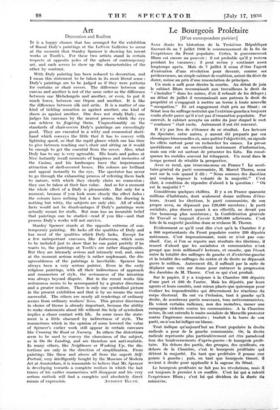Art
Decoration and Realism IT is a happy chance that has arranged for the exhibition' of Raoul Dufy's paintings at the Lefevre Galleries to occur at the moment that Stanley Spencer is showing his recent works at Tooth's. For these two artists stand in certain respects at opposite poles of the sphere of contemporary art, and each serves to show up the characteristics of the other by contrast.
With Dufy painting has been reduced to decoration, and I mean this statement to be taken in its most literal sense : Dufy's paintings are to be judged as if they were patterns for curtains or chair covers. The difference between one canvas and another is not of the same order as the difference between one Michelangelo and another, or even, to put it much lower, between one Orpen and another. It is like the difference between silk and satin. It is a matter of one kind of tickling sensation as against another, one kind of sheen as against another. One does not study Dufy; one judges his canvases by the nearest process which the eye can achieve to fingering them. Unquestionably on the standards of chair-covers Dufy's paintings are exceedingly good. They are executed in a witty and economical short- hand which conveys the little that it has to convey with lightning speed, so that the rapid glance which one has time to give between reaching one's chair and sitting on it would be enough to get the essential from the cover. Also, what Dufy has to say is very agreeable. His boats and palms at Nice instantly recall moments of happiness and memories of the Casino, and his landscapes have the, impermanent attraction of shell-covered boxes. His colours are brilliant and appeal instantly to the eye. The spectator has never to go through the exhausting process of referring them back to nature, with which they clearly claim no connexion ; they can be taken at their face value. And so for a moment the whole effect of a Dufy is pleasurable. But only for a moment, because if you look more closely the effect fades : the colours have nothing but a face value, the drawing is nothing but witty, the subjects are only chic. All of which facts would not be disadvantages if Dufy's paintings were actually meant for stuffs. But man has an incurable belief that paintings can be studied—read if you like—and that process Dufy's works will not survive.
Stanley Spencer stands at the opposite extreme of con- temporary painting. He lacks all the qualities of Dufy and has most of the qualities which Dufy lacks. Except for a few unimportant canvases, like Laburnum, which seem to be included just to show that he can paint prettily if he wants to, the paintings at Tooth's are rather disagreeable. But they are intensely serious and intensely real, and, since at the moment serious reality is rather unpleasant, the dis- agreeableness of the paintings is inevitable. Spencer has always been a very serious painter. Even in the early religious paintings, with all their indirectness of approach and mannerism of style, the seriousness of the intention was always beyond dispute. But in the recent works this seriousness seems to be accompanied by a greater directness and a greater realism. There is only one symbolical picture in the present exhibition and that is by no means the most successful. The others are nearly all renderings of ordinary scenes from ordinary workers' lives. This greater directness in choice of theme is already important, because the ability to make statements about life without the help of symbolism implies a closer contact with life. In some cases the state- ment is a little obscured by indirectness of style. The mannerisms which in the opinion of some lowered the value of Spencer's earlier work still appear in certain canvases like Crossing the Road or Nursery. In others the distortions seem to be used to convey the clumsiness of the subject, as in On the Landing, and are therefore not anti-realistic.
In many others, hie Neighbours or Washing Up, the dis- tortions are only in the direction of simplification. From
paintings like these and above all from the superb Self- Portrait, very intelligently bought by the Museum of Modern Art at Amsterdam, it is reasonable to believe that Mr. Spencer
is developing towards a complete realism in which the lait traces of his earlier mannerisms will disappear and his very serious outlook will find a complete and absolutely direct














































 Previous page
Previous page